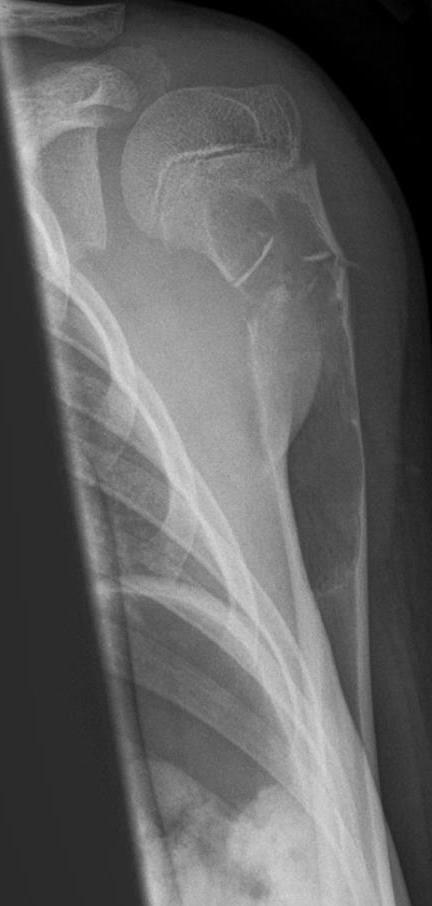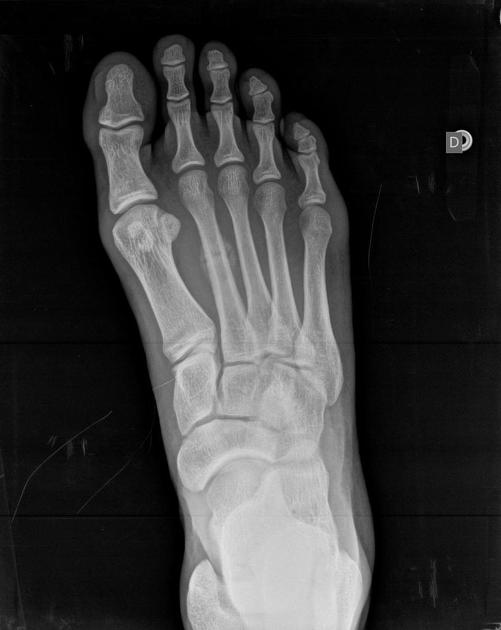fracture

A fracture is a discontinuity in a bone (or cartilage) resulting from mechanical forces which exceed the bone's ability to withstand them.
Terminology
Most commonly fractures occur in the setting of a normal bone with acute overwhelming force, usually in the setting of trauma. Fractures can also occur, however, in a variety of other settings.
Firstly, the entire skeleton may be weak due to metabolic (e.g. osteoporosis) or less frequently genetic abnormalities (e.g. osteogenesis imperfecta) and thus prone to fractures from forces that would be insufficient to cause fractures in normal bones. These are known as insufficiency fractures.
Secondly, the protracted chronic application of abnormal stresses (e.g. running) can result in the accumulation of microfractures faster than the body can heal, eventually resulting in macroscopic failure. These are termed fatigue fractures.
Together, insufficiency and fatigue fractures are often grouped together as stress fractures.
Thirdly, the bone may have a lesion that focally weakens a bone (e.g. metastasis, or bone cyst). These are known as pathological fractures.
Rarely the term 'fracture' is also used for non-osseous/chondral structures (e.g. penile fracture) although if unqualified it is assumed one is referring to a bony fracture.
Although many eponymous fractures exist and the relevant particulars of a fracture will depend on its specific location, generally fractures are described in a consistent manner:
Location
- which bone is fractured
- which part of the bone is affected
- general: epiphysis, physis, metaphysis, diaphysis
- specific features: e.g. tubercle, epicondyle etc...
Type
Fractures usually fall within a set number of patterns.
- complete fracture: extends all the way across the bone (most common)
- transverse fracture: perpendicular to the axis of the bone
- oblique fracture: oriented obliquely across the bone
- spiral fracture: helical fracture path usually in the diaphysis of long bones
- comminuted fracture: more than two parts
- incomplete fracture: does not cross the bone completely (usually encountered in children)
- bowing fracture
- buckle fracture: the cortex is buckled, often in the distal radius
- greenstick fracture: the cortex is broken, but only on one side
Displacement
The relationship between fracture fragments can be described using the following terms.
- fracture translation (a.k.a. translocation or displacement)
- direction: usually of the distal part relative to the proximal part
- amount: measurement or % width
- fracture angulation
- direction: usually of the distal part relative to the proximal part
- amount: in degrees
- fracture rotation
- direction: terminology will depend on the location
- amount: in degrees
- fracture length
- distraction/impaction/shortening
Complications
Many of the aforementioned fracture types can also go on to have additional complicating features, not to mention many associated soft tissue injuries beyond the scope of this article.
- compound fracture: extending through the skin
- joint involvement
- intracapsular
- articular
- dislocation
Pathology
The pathophysiological sequence of events that occur following a fracture and eventually (hopefully) lead to complete fracture healing are fairly stereotyped and can be divided into three main phases:
Inflammatory phase
Immediately at the time of fracture, the space between fracture ends is filled with blood forming a hematoma. Not only does this hematoma stop additional bleeding it also provides structural and biochemical support for the influx of inflammatory cells, fibroblasts, chondroblasts and the ingrowth of capillaries .
At the end of this process, which usually takes approximately a week, a primary callus (also known as soft-tissue callus, or procallus) is present which is non-mineralized and not readily visible on radiography .
Reparative phase
Over the ensuing few weeks this primary callus is transformed into a bony callus by the activation of osteoprogenitor cells. These cells lay down woven bone which stabilizes the fracture site .
Remodeling phase
The remodeling phase lasts many months, and even years, and represents the gradual formation of compact cortical bone with greater biomechanical properties and allows for the reduction of the width of the callus. In some instances, remodeling can result in almost perfect healing. In most instances, however, particularly if the alignment is not perfect, a residual deformity will remain.
Radiographic features
Fractures are generally imaged using plain radiographs, however, there are a number of situations in which CT or MRI or bone scans are useful:
- when 3D anatomy is complex (e.g. joints, wrists, feet, base of skull, spine)
- when plain films are insensitive to non-displaced fractures (e.g. base of skull, spine, sacrum, or proximal neck of femur)
- when a pathological fracture is suspected
Both plain radiographs and CT rely on identification of discontinuity of bone at the fracture site. In contrast, MRI relies primarily on visualizing soft tissue and bone marrow changes, whereas nuclear medicine (e.g. bone scans) visualizes bone metabolic changes.
Ultrasound is generally insensitive to fractures although it can also sometimes detect cortical deficiencies.
Treatment and prognosis
The fundamentals of fracture healing rely on alignment and immobilization. Alignment may or may not be necessary depending on the degree of displacement, the importance of correct alignment (e.g. index finger vs rib) and the particulars of the patient (e.g. professional athlete vs debilitated elderly).
Immobilization can be achieved in a variety of ways depending on the location and morphology of the fracture.
- none (e.g. most rib fractures)
- sling (e.g. many clavicular fractures)
- cast (e.g. many forearm fractures)
- internal fixation (e.g. most hip fractures)
- external fixation
Siehe auch:
- Frakturen mit Eigennamen
- pathologische Fraktur
- Grünholzfraktur
- indirekte Frakturzeichen
- Insuffizienzfraktur
- Fraktur im Röntgen frisch oder alt
- Knochenkontusion
- Ermüdungsbruch
und weiter:

 Assoziationen und Differentialdiagnosen zu Fraktur:
Assoziationen und Differentialdiagnosen zu Fraktur:




